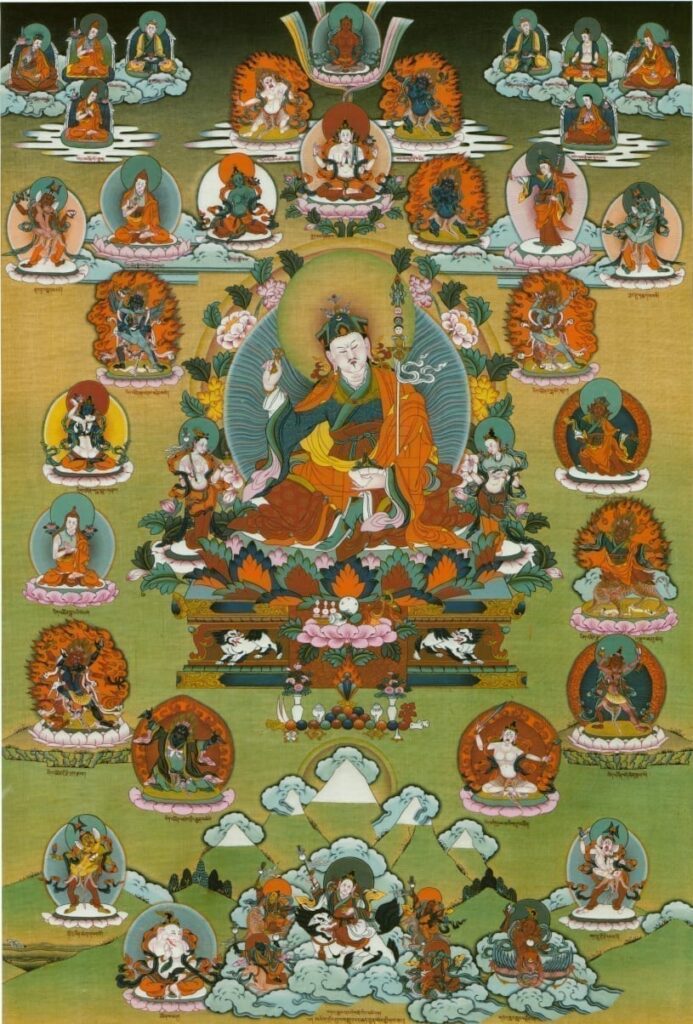The Lamé Tukdrup Barché Künsel is a cycle of teachings revealed by Chokgyur Lingpa and Jamyang Khyentse Wangpo. The cycle forms around one-third of the New Treasures of Chokgyur Lingpa, about ten volumes of Tibetan texts. Tukdrup means ‘Heart practice,’ Barché means ‘obstacles’, and Künsel means ‘dispeller of all’.
Kyapjé Dilgo Khyentsé Rinpoche spoke about the cycle:
The Barché Künsel is the heart essence of the accomplished master Padmasambhava, who perceives the three times in their entirety. It is the quintessence of one billion heart sadhanas of the guru, the most unique terma, buried in the land of Tibet. It is also the first of the Four Cycles of Guru Sadhana. This Guru’s Heart Practice, Dispeller of All Obstacles contains in completeness all the profound key points of the view, meditation, and conduct of the three inner yoga tantras. It manifested from the secret treasury of great wisdom, the vast realization of the Second Buddha of Uddiyana, as self-existing, natural vajra sounds in perfect, melodious tones. Its expressions, which are unmodified by the intellect of ordinary people; its words, which are without delusion; and its meaning, which is unmistaken, are exclusively due to the kindness of the three powerful knowledge holders, Khyentsé, Kongtrül, and Chokling, the great beings of the three families, who incarnated as masters to compile and propagate an ocean of secret teachings. It is exclusively through their kindness that this teaching was established in writing, as the splendor of unending welfare and happiness for disciples in the Land of Snow, and propagated to flourish everywhere. This pure and perfect teaching, which effortlessly bestows, in accordance with one’s wishes, the all-encompassing supreme, and common siddhis, temporarily and ultimately, was an unprecedented diffusion of the gemstones of profound meaning, opening up the treasury of the universal monarch.
Dispeller of Obstacles: The Heart Practice of Padmasambhava, trans. Erik Pema Kunsang, ed. Marcia Dechen Wangmo. Rangjung Yeshe Publications: Hong Kong, 2014.
The Tukdrup Barché Künsel is not just an ordinary teaching composed by somebody, it is a valid teaching endowed with the richness of blessings, siddhis, love, care, compassion, and auspiciousness from Guru Rinpoche and Dakini Yeshe Tsogyal. This is a special heart practice of Guru Rinpoche and he gave it to us right now, a teaching that is meant for these times. This treasure teaching is also special as it was revealed as an earth treasure by Chokgyur Lingpa and a mind treasure by Jamyang Khyentse Wangpo. Moreover, Chokgyur Lingpa kept it hidden for eight years, as he practiced in secret and attained all the signs of accomplishment.
This cycle focuses on the dharmakaya Amitayus, sambhogakaya Ngensong Dongtruk (a form of Avalokiteśvara) and the nirmanakaya Padmasambhava. Within the cycle, there are extensive, medium, and condensed practices for all twelve emanations of Guru Rinpoche.
The dharmakaya Amitayus, the Buddha of longevity, was the first cycle that Guru Rinpoche bestowed on his students as part of the Tukdrup Barché Künsel. The cycle for the Great Compassionate One, the sambhogakaya Avalokiteśvara, was the second cycle bestowed by Guru Rinpoche. Avalokiteśvara reaches out to all beings of samsara, freeing them from the lower realms.
Practicing the Cycle: Advice from Jamyang Khyentse Wangpo:
According to the system of the omniscient master, Padma Ösel Do-Ngak Lingpa, perform, as the beginning of the main part, the single mudra according to the Gyungyi Koljang, the Concise Daily Practice Manual, as ‘approach’; the condensed outer mandala of Trinley Nyingpo as the ‘full approach;’ Trinley Dringpo, the Medium Practice Manual, as ‘accomplishment;’ and Trinley Gyepa, the Extensive Practice Manual, together with Dzapkyi Koljang, the Recitation Manual, and so forth in a detailed way for the ‘great accomplishment.’ The samadhis and visualizations for the recitation of these should conform with the root text of the third chapter (of Sheldam Nyingjang). Having properly performed the four aspects of approach and accomplishment, perform then the ‘specific practices’ such as those for Dharmakaya, Sambhogakaya, and so forth, whichever is suitable. There is no difference between following either of these two systems since they both are lords of these profound teachings.



